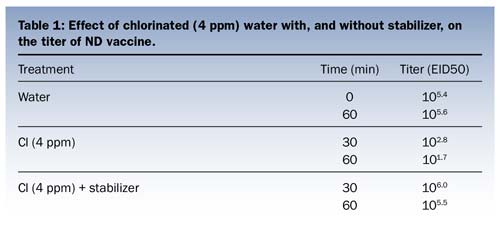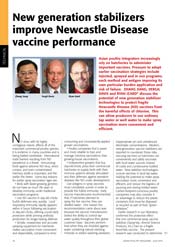 Asian poultry integrators increasingly rely on hatcheries to administer important vaccines. Pressure to adopt earlier vaccination strategies include injected, sprayed and in ovo programs, each method and antigen imposing its own particular burden application and risk of failure. ZHANG JIANG, VERGIL DAVIS and RYAN IZARD* discuss the potential of new generation stabilizer technologies to protect fragile Newcastle Disease (ND) vaccines from the harmful effects of chlorine. This can allow producers to use ordinary tap water or well water to make spray vaccination more convenient and efficient.ND virus, with its highly-contagious nature, affects all of the important commercial poultry species. It is endemic in many countries and is being battled worldwide. International trade barriers resulting from ND prevalence is a threat. Immunizing birds against airborne ND virus, direct contact, and even contaminated hatchery shells is important; and the earlier the better. Some key reasons for earlier spray vaccination ages are:
Asian poultry integrators increasingly rely on hatcheries to administer important vaccines. Pressure to adopt earlier vaccination strategies include injected, sprayed and in ovo programs, each method and antigen imposing its own particular burden application and risk of failure. ZHANG JIANG, VERGIL DAVIS and RYAN IZARD* discuss the potential of new generation stabilizer technologies to protect fragile Newcastle Disease (ND) vaccines from the harmful effects of chlorine. This can allow producers to use ordinary tap water or well water to make spray vaccination more convenient and efficient.ND virus, with its highly-contagious nature, affects all of the important commercial poultry species. It is endemic in many countries and is being battled worldwide. International trade barriers resulting from ND prevalence is a threat. Immunizing birds against airborne ND virus, direct contact, and even contaminated hatchery shells is important; and the earlier the better. Some key reasons for earlier spray vaccination ages are:
• Birds with faster-growing genetics do not have as much life span to develop immunity under traditional vaccination programs.
• Live ND vaccine in day-old chicks builds defenses very quickly. Local respiratory immunity rapidly appears within 4 hours following vaccination in day-old chicks, offering crucial early protection while priming antibody production for longer-lasting defense.
• Simple, inexpensive and accurate spraying equipment for hatcheries makes vaccination more convenient and dependable, compared to time-consuming and inconsistently-applied grower vaccinations.
• Poultry companies find it easier and more reliable to train and manage hatchery vaccinations than growing-house vaccinations.
• Independent growers that buy day-old-chicks press their commercial hatcheries to supply birds with their immune systems already stimulated and their defenses against prevalent diseases like ND under development.
Live antigens in spray vaccinesmust completely survive in order to provide the fullest immunity. Early vaccine manufacturers recommended that, if hatcheries planned to spray the live vaccine, they use distilled water. One reason this recommendation came about was because the vaccine manufacturers lacked the ability to control tap water quality throughout their global customer base. Vaccines perform best when they are shielded against water containing natural oxidizing minerals or added oxidizing sanitizers,inappropriate pH and unbalanced electrolyte concentrations. Modern, new-generation vaccine stabilizers are reported to counteract these risks, rescuing vaccines so hatcheries can conveniently and safely vaccinate with local water sources instead of costly and cumbersome bottled water. New stabilizer technologies nurture vaccines in local tap water, holding the potential to make spray vaccination more convenient and efficient, and reduce the logistics of sourcing and storing bottled water. Carbon-footprint-conscious poultry companies may also consider it an advantage to reduce the plastic containers that must be disposed or recycled as part of their “green initiatives.”
Earlier research in our laboratory confirmed the protective effect that one commercial spray vaccine stabilizer (Spray-Vac, Animal Science Products, Inc.) had on a fragile bronchitis vaccine. The resent research was conducted to determine if the stabilizing properties extend to ND vaccine in water with high oxidative potential.
Summary
A live freeze-dried ND vaccine rehydrated in water was introduced into (a) more water alone, (b) water containing free available chlorine at 4 ppm, or (c) water containing free available chlorine at 4 ppm plus stabilizer at the point-of-use concentration. Vaccine virus was titrated in specific-pathogen-free(SPF) embryos at 0 and 60 minutes for the water-alone treatment, and at 30 and 60 minutes for both the chlorine and chlorine plus stabilizer treatments. It was determined that the stabilizer fully protected the vaccine virus from the deleterious effect of free chlorine at 4 ppm.
Materials and Methods
The method used is the longstanding experimental model common to vaccine manufacturers for validating the initial potency of each production lot of ND vaccines, published in Title 9, U.S. Code of Federal Regulations §113.329.
Spray vaccine preparation
A representative vial of commercial freeze-dried vaccine containing 1,000 doses was locally obtained and rehydrated according to label directions as a hatchery normallywould with 10 mL of sterile water. The vaccine vial was gently agitated to uniformly disperse solid particles. To prepare for titrations, the vaccine was then further diluted to 1 label dose per mL in each of 3 prepared spray solutions and held at room temperature throughout the experiment:
1. Positive control- Distilled water common to hatcheries.
2. Negative control- The same distilled water with added oxidizer standardized at 4 ppm chlorine to replicate hatchery tap water.
3. Stabilized- The same water as the negative control with liquid stabilizer added at the recommended concentration of 32 mL per liter of spray. EID50 vaccine titrations
Each of these 3 initial spray solutions served as the 100 dilution, and was then 10-fold serially diluted with separate transfer pipettes for embryo inoculations. Titrations were conducted using specific-pathogenfree (SPF) embryonated eggs. Each titration was replicated 3 times, inoculating 6 10-day SPF eggs at each dilution.
The distilled water positive control was titered immediately to measure the amount of live vaccine virus input at time 0, then again at the 60-minute endpoint. The negative control replicating tap water and its stabilized counterpart were both titered after 30 and 60 minutes in the spray solutions.
All incubating embryos were candled daily. Embryos that died within the first 24 hours following inoculation were considered unrelated to virus effects and were disregarded. Thereafter dead embryos were refrigerated immediately after candling. After 7 days incubation, surviving embryos and dead ones in the highest dilution that also contained live embryos were tested for HA activity using a 5% suspension of red blood cells, coming led from 3 adult SPF chickens, in phosphate buffered saline. Embryos were counted as positive if they had died, or if they were HApositive. A titer was considered valid when the most concentrated dilution had 50 to 100% positives, and the least concentrated dilution had 0 to 50% positives. The method of Reed and Muench was used to calculate the EID50 per dose.
Results
The effect of stabilizer on the titer of ND vaccine in chlorinated water is detailed in Table 1. Geometric mean titers (GMT) of the ND vaccine in distilled water (positive control with no exposure to chlorine) at the input time zero and after 60 min were 105.4 and 105.6 EID50 /mL, respectively. This is the baseline titer a hatchery would expect under normal conditions when spraying with distilled water. The GMT of the replicated-tap-water negative control (vaccine exposed to water containing chlorine and no stabilizer) were 102.8 and 101.7 EID50 /ml at 30 and 60 minutes, respectively. The 2.8-log reduction after only 30 minutes means the non stabilized vaccine had already lost over 99 .7% of its value. In contrast, the titers of the stabilized solution (vaccine diluted in water containing 4 ppm chlorine and Spray-Vac) increased at the 30-minute interval to 106.0 and 105.5 EID50 /mL at 60 minutes.
Discussion
In order to successfully immunize chickens via spray, one of the most important considerations centers on delivery of live virus at the recommended dosage. To accomplish adequate delivery, spray equipment must be fully functional, the operator must uniformly deliver the spray over the chickens, the virus must be rehydrated to the proper dilution and the virus must remain viable in the diluent, which is commonly drawn from a distilled water bottle or a water tap. Thesteadily increasing number of hatchery vaccinations places a greater burden on sourcing and storing distilled water, and disposing of the bottles. Spraying with tap water that is readily available, convenient and inexpensive is a more sustainable alternative; however, water quality always poses some risk to the vaccine unless it is first stabilized. Water can challenge a vaccine’s immunizing potential if harmful oxidizing elements are present.
This trial was conducted to assess both (1) the degree of ND virus inactivation induced by water containing a common amount of oxidizer and (2) the rescue effect of stabilizer on ND virus in the same water. ND vaccine virus was chosen as the specimen virus because of its wide-spread use in chickens by the spray route. The chlorine concentration of 4 ppm was chosen because it represents a challenge to the stabilizer and is an oxidative element within a range normally encountered in municipal or well water systems. A pilot study previously conducted inthis laboratory had confirmed the ND vaccine’s sensitivity and helped establish the appropriate titration dilutions for the present experiment.
The viability of the vaccine virus degraded rapidly in non-stabilized spray water containing normal concentrations of oxidizer, and continued to do so through the 60-minute incubation. The stabilizer was very effective in preserving the viability of ND vaccine virus in the presence of 4 ppm free chlorine, even up to one hour. At 30 minutes, the stabilized chlorine solution had over 1,500-fold more live virus than the same solution without stabilizer. At 60 minutes, stabilizer bolstered virus survivability by over 6,000-fold when compared to the effect of chlorine alone.
Although traditional statistical approaches do not provide insight into differences where logarithmic virus growth and senescence are concerned, biological variation becomes significant in terms of virus titer as it approaches 10-fold (one-log) differences. Among the four titers for the distilled water andstabilized groups, the titer in distilled water alone at time zero was the lowest. Although precautions were taken to avoid vaccine aggregates, one possible explanation is that upon rehydration of the freeze-dried vaccine cake, inconspicuous small clumps may remain in suspension, containing more viral particles than expected. Testing this explanation will require many more titration studies and thus, remains a continuing object of investigation.
*Zhang Jiang ([email protected]) is Dean of Department of Biotechnology and Eco-technology, Shanghai Vocational College of Agriculture and Forestry, PRC, Vergil Davis ([email protected]) is President with Lasher Associates, USA, and Ryan Izard ([email protected]) is Chief Science and Technology Officer with Animal Science Products, Shanghai, PRC.

